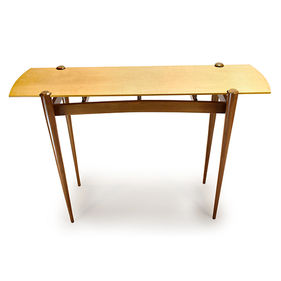Eric Carr Fine Furniture
Woodworking, Mixed Media Arts
2022531010
Originally from Los Angeles, I worked for over twenty years as a graphic designer in the D.C. area before deciding to switch careers on my 45th birthday to make studio furniture fulltime. My style is a cross between Mid Century Modern and Arts and Crafts because I love the natural simplicity of and clean lines these styles bring to my pieces. I am largely self-taught, though I have taken classes at the Corcoran and the North Bennet Street School. In designing these pieces, I start with pencil sketches of what I am hoping to achieve and then turn to 3D modeling programs to refine the joinery and scale. Of course, no plan survives first contact with the enemy and in woodworking, sometimes the enemy is the wood itself, which does not always behave in predictable ways. Most people do not realize that wood furniture is still a living breathing thing even once the tree is cut down, the wood kiln dried, and the boards milled to thickness, reshaped, glued and varnished into a chair. The furniture will expand and contract with the seasonal movement and solid joinery design is a must for the piece to survive.
My inspiration comes from a wide variety of sources, but often stems from an attempt to solve a specific design or construction problem. The “I Cannot Tell A Lie” table is a perfect example. The table started life as a prototype for another, as yet unbuilt, table which will use a piece of Osage Orange wood that was cut from the grounds of Capitol Hill during the visitor center expansion. I had been thinking about using books as part of the base. Not wanting to use my one precious piece of wood until I had the design fully developed and had figured out how to incorporate books into a stable piece of useable furniture, I instead started with a piece of live edged cherry wood. The cherry wood prompted me to think about the apocryphal story of George Washington as a small boy chopping down his father’s prize cherry tree with the child-sized ax and announcing, “I cannot tell a lie, I cut down the tree”. This in turn led me to think about the ways that “truth” in relation to political figures is always a somewhat malleable concept – one that requires us to have an evolving understanding of historical lives as our society continues to develop. In Washington’s case, that requires us to see him both as our most highly celebrated founding father, whose noble decision to step down from power at the end of his second term gave us the gift of a functional democracy with a peaceful transition of power, and, also, at the same time, as someone who owned other human beings and profited from slavery. This ugly yet fundamental truth forms the base for the pedestal of books holding up one end of the table while the ash wood shelf (ash is used for axe handles), and the hand forged axe head tusk tenons allude to the “lie” of the mythology around this great man. Working to ensure that the books could be physically stable enough to support a functional table, presented other technical challenges and required careful experimentation with the form and the structure.










